Input interpretation

white phosphorus
Chemical names and formulas
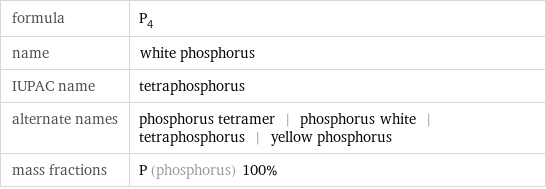
formula | P_4 name | white phosphorus IUPAC name | tetraphosphorus alternate names | phosphorus tetramer | phosphorus white | tetraphosphorus | yellow phosphorus mass fractions | P (phosphorus) 100%
Lewis structure
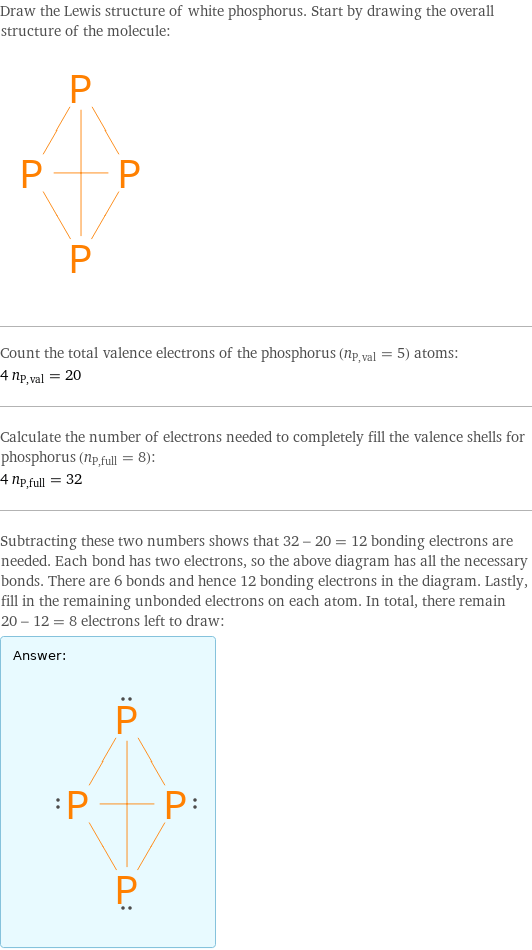
Draw the Lewis structure of white phosphorus. Start by drawing the overall structure of the molecule: Count the total valence electrons of the phosphorus (n_P, val = 5) atoms: 4 n_P, val = 20 Calculate the number of electrons needed to completely fill the valence shells for phosphorus (n_P, full = 8): 4 n_P, full = 32 Subtracting these two numbers shows that 32 - 20 = 12 bonding electrons are needed. Each bond has two electrons, so the above diagram has all the necessary bonds. There are 6 bonds and hence 12 bonding electrons in the diagram. Lastly, fill in the remaining unbonded electrons on each atom. In total, there remain 20 - 12 = 8 electrons left to draw: Answer: | |
3D structure

3D structure
Basic properties
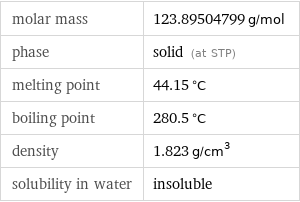
molar mass | 123.89504799 g/mol phase | solid (at STP) melting point | 44.15 °C boiling point | 280.5 °C density | 1.823 g/cm^3 solubility in water | insoluble
Units

Solid properties (at STP)

density | 1.823 g/cm^3 vapor pressure | 0.026 mmHg (at 20 °C)
Units

Thermodynamic properties

specific heat capacity c_p | gas | 0.1679 J/(g K) | solid | 0.1921 J/(g K) molar heat capacity c_p | gas | 20.8 J/(mol K) | solid | 23.8 J/(mol K) specific free energy of formation Δ_fG° | gas | 2.261 kJ/g molar free energy of formation Δ_fG° | gas | 280.1 kJ/mol specific heat of formation Δ_fH° | gas | 2.555 kJ/g | solid | 0 kJ/g molar heat of formation Δ_fH° | gas | 316.5 kJ/mol | solid | 0 kJ/mol specific entropy S° | gas | 1.317 J/(g K) | solid | 0.3317 J/(g K) molar entropy S° | gas | 163.2 J/(mol K) | solid | 41.1 J/(mol K) molar heat of vaporization | 12.4 kJ/mol | specific heat of vaporization | 0.1 kJ/g | molar heat of fusion | 0.659 kJ/mol | specific heat of fusion | 0.00532 kJ/g | critical temperature | 994 K | (at STP)
Chemical identifiers
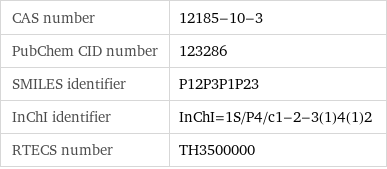
CAS number | 12185-10-3 PubChem CID number | 123286 SMILES identifier | P12P3P1P23 InChI identifier | InChI=1S/P4/c1-2-3(1)4(1)2 RTECS number | TH3500000
NFPA label

NFPA label
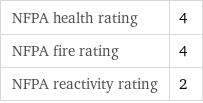
NFPA health rating | 4 NFPA fire rating | 4 NFPA reactivity rating | 2
Safety properties

flash point | 20 °C autoignition point | 30 °C

DOT hazard class | 4.2 DOT numbers | 1381 | 2447
Toxicity properties

odor | odorless lethal dosage | 3 mg/kg (oral dose for rats) short-term exposure limit | 0.3 mg/m^3

probable lethal dose for man | 4 mL (milliliters) long-term exposure limit | 0.1 mg/m^3 (over 8 hours) RTECS classes | agricultural chemical and pesticide | reproductive effector | human data